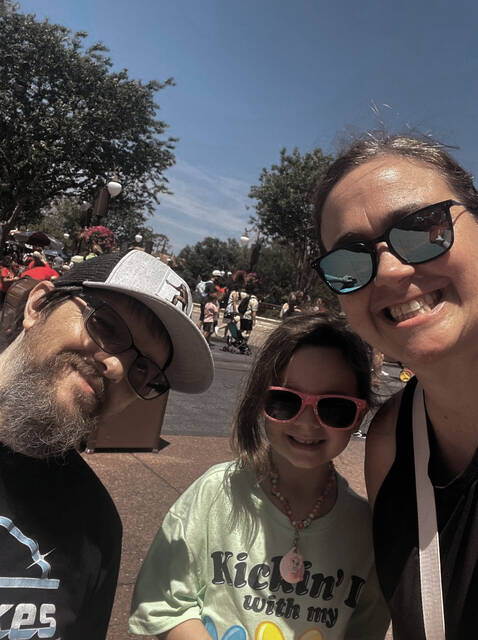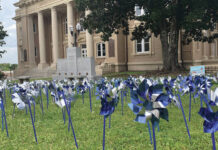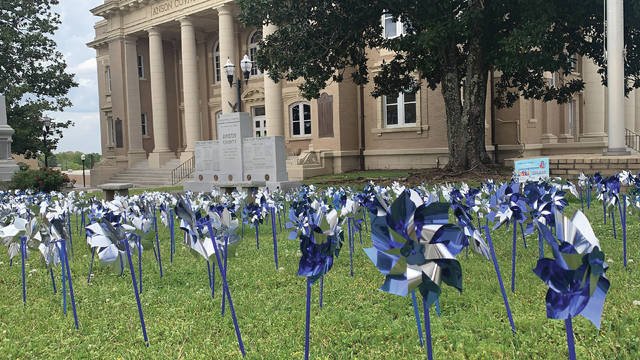
Lee, his daughter, and wife Callie; whom he credits with pulling him through his recovery.
Provided courtesy of Joseph Lee
The month of May is dedicated to raising awareness for Lupus, Mental Health, and Strokes. In honor of bringing awareness to strokes, I recently reconnected with two former classmates of mine, Joseph Lee who had a stroke August 2, 2022, and his wife Callie.
Lee had a hemorrhagic stroke near his basil ganglia. He remembers “I had to look up the description on the after-visit summary. It said, ‘acute hemorrhage of basal ganglia.’ Basically, a blood vessel leaked near my brain which fried a bunch of nerves that control the left side of my body.”
At the time of his stroke, Lee was at home having lunch with his wife Callie, who noticed he started talking funny suddenly. The two were carrying on a conversation from separate rooms, so when Lee tried to tell his wife that he did not think he was talking funny, she immediately rushed to his side.
Lee says “That is when we realized I couldn’t sit up straight. We immediately freaked out and called 911. At the time, we didn’t know what was happening, but we had a good idea.”
At the hospital, Lee was lucky and blessed to learn he had not suffered any memory or speech issues with his stroke. He did, however, have to contend with damage from the stroke that cost him the ability to move his arm, hand, leg, ankle and toes on the left side of his body.
Laid up in the hospital and trying to recover, Lee’s thoughts remained focused on his wife and daughter.
“One of my goals was to carry my daughter around again. I have accomplished it too,” says Lee with fatherly pride.
After the stroke, Lee admits it was hard for him to ask for help. He recalls, “I didn’t want to be a burden to anyone. It took a lot of time for me to start asking for help with the simplest things, like getting dressed and bodily maintenance. I spent the first month at Carolina Rehab in Charlotte where I had the most amazing physical therapist and occupational therapist professionals teaching me the exercises I would need to recover. It took me about eight months to relearn to walk.”
Lee says his recovery process will never end and is consistently ongoing.
“I use hand braces and different apparatus to stretch my fingers daily and use an AFO (ankle/foot orthotic) to keep my left foot from dragging,” says Lee. “I have specific shoes I wear to ensure I do not fall over etc., and because I have not been able to use the muscles on my left side for three years, several of my muscles have ‘atrophied.’ That is why I will never be out of recovery and why [recovery] is so important. If you see me shrugging, I’m not unsure, I’m working out my shoulders to keep that left one from falling out of socket,” he explains.
Lee adds, “Life gets back to ”normal” if you put the effort into recovery. You can get back to the things you want to do.”
Or as we said when I was in nursing; “If you don’t use it, you lose it.”
One of the things Lee says has touched him the most is the outpouring of love he has received.
“The amount of love, help and encouragement from friends and family is overwhelming. Recovery is interesting, it is constant, and I am told it will never stop. I work out more now than before the stroke.”
When it comes to what could have caused his stroke, Lee remains baffled.
“I get asked a lot about why my stroke occurred and unfortunately, we probably won’t ever know. I was in good health and did not drink or use drugs.”
Reflecting on those early days following his stroke, Lee advises stroke victims to remember to take a moment for themselves.
He says, “I’m going to say this like it is easy, but I cannot stress how difficult it is. Take a moment to breathe [because] things will be moving fast around you. Allow people to take care of you. It was difficult for me to not be wholly independent anymore.”
Lee says that while many things changed for him after his stroke, one of the hardest changes to reconcile himself to was in his profession.
“This biggest difference would be [in my] work and day to day life. At work, I went from being a hydraulics expert that could fix anything, to now I can only tell people how, but can’t physically repair anything. At home I was the runaround- the -yard dad and now I’m more like a sideline coach.”
While in nursing, I had a stroke patient in her thirties who was a registered nurse. Her stroke happened while she was at work in the Emergency Room. As my patient, she was in recovery and one of my happiest memories from my healthcare days is of helping her learn to reapply her make-up and seeing her finally get to leave our rehabilitation center and get an apartment of her own.
A few years back my father, Rick Wilson, suffered an ischemic stroke.
He explains, “Ischemic strokes happen when a blood clot blocks a blood vessel in your brain.” He adds, “The sooner you can get treatment, the better.”
Lee agrees, and now works towards spreading stroke awareness, not only during the month of May, but also year-round.
My patient, the former nurse, frequently reminded us nursing staff of not only the signs of a stroke, but of how young and healthy she was at the time of hers. Like my dad and Lee, she also did not drink or smoke. Physically fit, she often participated in marathons.
Like how Lee could not sit up during his stroke, my dad knew he was having a stroke when he looked in the mirror and could not smile. My grandmother had mini strokes that “killed” part of her brain every time she had them. Unbeknownst to family, doctors told my mother she had been having these strokes since she was in her forties- we did not know until my grandmother was in her seventies. My husband’s mother had a massive stroke following a visit at our house, passing away suddenly.
Through my experience with my own family, and hearing the stories of Lee and many former patients of mine, I have learned knowing the signs of a stroke are key.
While there are many signs someone is having a stroke, some of the top five signs a stroke is occurring are: weakness or numbness of the face, arm, or leg, usually occurring on one side of the body, trouble speaking or understanding others, problems with vision such as dimness or complete loss of sight in one or both eyes, dizziness or problems with balance and coordination or movement and walking.
If you feel you may be having a stroke, doctors recommend becoming familiar with BE FAST fast; B- Check the person’s balance- look for sudden difficulty with walking, standing, or dizziness, E= Check for sudden vision loss or changes in one or both eyes, such as blurred or double vision, F= ask the person who may be having a stroke to smile. Does one side of their face droop or does their smile appear uneven? A= ask the person to raise both arms. Does one arm continuously drift downward? Is the person unable to lift one of their arms? S= Ask the person to repeat simple words or phrases. Does their speech sound slurred or difficult to understand? T= Time is critical. If you or anyone you know is experiencing these symptoms, seek immediate medical care.



